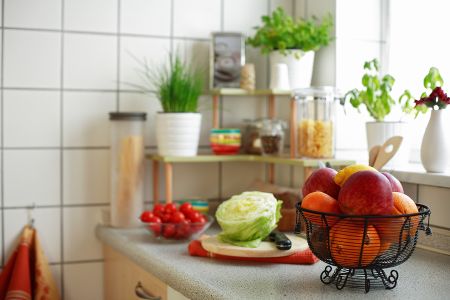

Setting out a bowl of fruit, keeping the kitchen clean, and using a juicer: being healthy doesn’t require an extreme kitchen makeover – you can gradually approach your goals and find your comfort zone. How to begin? Try these simple changes to live healthier.
We never stop running: running to work, to make deadlines, to errands and appointments, even to make vacations work. Such a frantic frame of mind makes it hard to take a moment for ourselves to breathe right, eat right, and improve our well-being. Who has the time to make healthy food when the children are screaming and the house is a mess? The basic instinct is to pop a pizza into the microwave or order in and have an instant meal.
The result of such disregard towards health and eating can be observed through obesity, diabetes, cholesterol, hypertension, and other disease statistics. On the other hand, preparing homemade food from scratch in a healthy environment can help you avoid processed food containing refined staples, artificial colors and flavorings, sugar, sodium, preservatives, and other undesirable components. (jaximplant.com) What can be done to promote such a change in your home?

1. Get a food processor that’s easy to clean and use
This investment allows you to prepare healthy dishes and fresh, pure versions of popular store-bought delicacies with a lot less time and effort – and often for less money. Using such an appliance can help make homemade tahini, nut butters, guacamole, and other spreads, plus baked goods, soups, shakes, veggie burgers, salads, and more.
2. Set out serving bowls or baskets filled with fruits and vegetables around the house
Having rinsed fruits or vegetables on the dining table or kitchen counter in plain view and with easy access is a simple way to increase everyday consumption. What we see and what is easy to grab and ready-to-eat is more appealing than what’s hidden. It may be just what you need after a hard day at work – and you can be content with a healthier food than other choices you might have otherwise made. The result: added natural source vitamins, minerals, nutritional fiber, and antioxidants – possibly translating to less bodyfat, fatigue, and other health problems.
3. Fill a large pitcher with water, lemon and mint
Sugary soft drinks can cause an increase in blood sugar, insulin, and fat levels, which can spell both diet and general health disaster. Additionally, these drinks often have added artificial colors, flavors, and preservatives. Diet drinks aren’t recommended, because artificial sweeteners have been linked to indigestion, allergies, and increased risk of cancer, and even diet sabotage through abnormally increased appetite.
Water is the only drink that universally has no bad effect on our health, and actually betters it. For those who find remembering to drink enough water to be a challenge, it is recommended to fill a large pitcher with cold water (cold during hot weather or tepid during cold weather). Adding natural, healthy, calorie-free flavoring agents such as slices of lemon and whole tea-like herbs such as mint leaves can improve the taste and the benefits.
During the especially cold months, you can keep herbal, caffeine-free “teas” in teapots as a nice addition to drinking water throughout the day.
4. Keep a tidy dining table
Keep newspapers, mail, and bills off the dining table. Just as you expect your partner to concentrate only on you during a conversation, you should treat the food on your plate similarly: give it the respect and attention it deserves. Enjoy your food and eat slowly, in a way that can reflect the respect you have for your body and health.
Do yourself a favor and remove any distraction on the dining table that might make you avoid “looking your food in the eye”.
5. Devote one day per week for healthy shopping and cooking
Adopting a healthy lifestyle requires organizing and planning ahead the shopping and cooking days. Devote one day a week for stocking up on healthy groceries and cooking.
If you plan your healthy food ahead for the rest of the week, you’ll decrease the number of chances of eating unhealthy food.
6. Are you a fan of fresh-squeezed juices? Get a good juicer, blender, or bullet to make the whole, fresh, real thing.
Make yourself fruit or vegetable juice in a blender, and you’ll profit from the full nutritional value, including the natural fibers that help balance blood sugar levels, give a sense of fullness, and may help lower your cholesterol levels. The better the tool, the more nutrients can be released.
High blood sugar? If you aren’t going to use the whole pureed fruit, be sure to dilute the juice with an equal amount of water before drinking, as the concentration of sugar is increased with juicing.
7. Freeze your food
Freeze extra portions of the food you make during the day(s) you dedicate to healthy cooking. These dishes will be ready for when there is very limited time for food preparation. Not having healthy food ready and on-hand can give rise to temptation for faster, unhealthy foods.
A way to improve this healthy change is to freeze the different parts of the dish separately and not as a whole meal. For instance, freeze rice, lentils, and so forth in separate containers. When the time comes, mix the different ingredients together to make a final dish. This may not be possible with all foods, such as most tofu – in this case, try placing portions in marinade in the coldest part of the refrigerator to prolong freshness.
This way you extend the foods’ shelf life, and more importantly, give yourself the flexibility to prepare several healthy meals combining different ingredients with minimum effort.
8. Grind flaxseed in a coffee grinder
Every healthy kitchen should have whole flaxseed in the refrigerator or freezer. Flaxseed is popular as a source of fiber to help with digestion and constipation. While and grinding them makes them more usable by the body, storing them whole at a cold temperature preserves their value – as they are very vulnerable to oxidation. Flaxseed is an important source of a key omega-3 fatty acid, alpha linolenic acid (ALA), which helps in reducing blood fat levels, maintaining health of the blood vessels and the heart, and supporting nervous system function.
Add ground flaxseed to yogurt or a salad or shake, bake it into bread, or use it to thicken sauces.
9. Keep the kitchen as well as appliances and utensils clean
A clean kitchen and tools will allow you to enjoy healthier and tastier food. Thoroughly clean your cutting board before and after using it – especially for high-protein foods such as meets – and change it every 3 months, since it tends to accumulate contaminants in the knife grooves. In addition to washing your dishes, be sure to wash your sink and counter using natural cleaners such as water, lemon, and salt, and not just soap or soapless soaps.
Keep pests away using natural means such as different herbs. For example, cinnamon sticks can keep ants away, and this will save you the added risk of pesticides.
10. Listen to calm music
Playing calm and pleasant music while cooking or eating will allow you to become more tranquil, which contributes a great deal to health. Instead of talking, arguing, reading, or watching television during a meal, try to just listen to music, concentrate on what’s on your plate, and eat slowly and enjoy every bite.
Learn more about the Trim Down Club by clicking here.
Comments 10
Leave a Reply
You must be logged in to post a comment.




Hi, David and Julie! Honey is fine, especially if “raw” and relatively unprocessed/unrefined. However, it is still a source of sugar, and so can add up quickly – use in moderation 🙂 You can read more about recommended and not-so-recommended sweeteners here https://www.trimdownclub.com/the-best-way-to-sweeten-your-tea-2/.
I’d like to know about using honey, too. Is it allowed on the plan? I’ve just begun this week.
I like the idea of having something on hand that I can just grab and eat…like fruit or nuts.
Can I have honey on my oatmeal?
Hmmmmmm
Clean the Kitchen as a motivator…
Okay, I’ll try it.
It is depressing to come in to a messy kitchen area.
Can’t hurt.
Great ideas. I never thought much about keeping the kitchen clean and tidy as a motivator, but I’ve been doing that & unbelievably, it helps. I’d also like to say depression keeps a person stuck in a state of “don’t wanna do anything” – which includes staying on track. Since I’ve gotten my depression under control, I’ve stopped beating myself up for backsliding, I keep the house cleaner, stay more organized and motivated.
Can we make flaxsee oil from flaxseed?
Thanks for the tip on how to grind Flax seed
I didn’t know about the flaxseed, thanks for that tip..
I know most of the ideas but it is good to review. Thanks